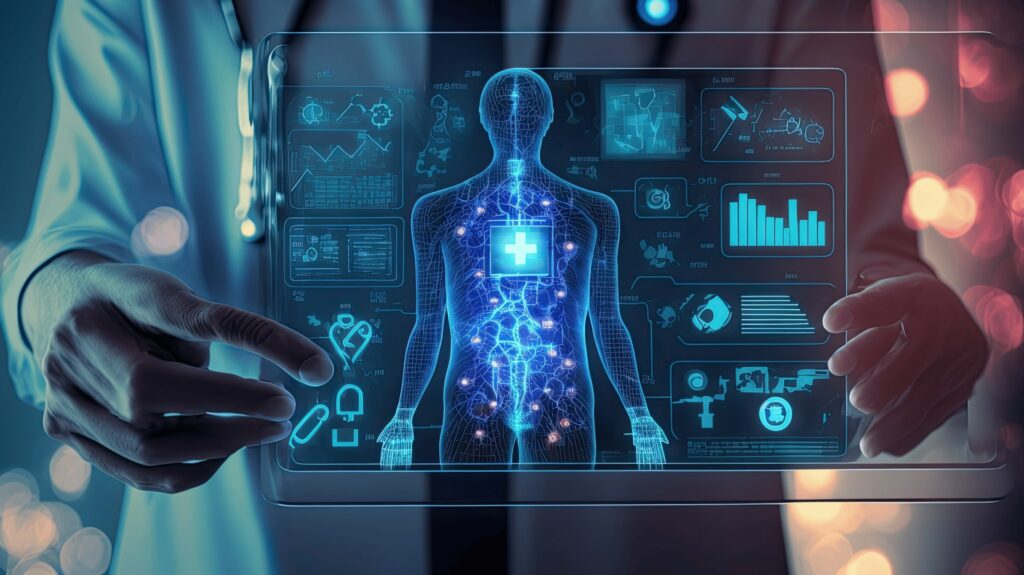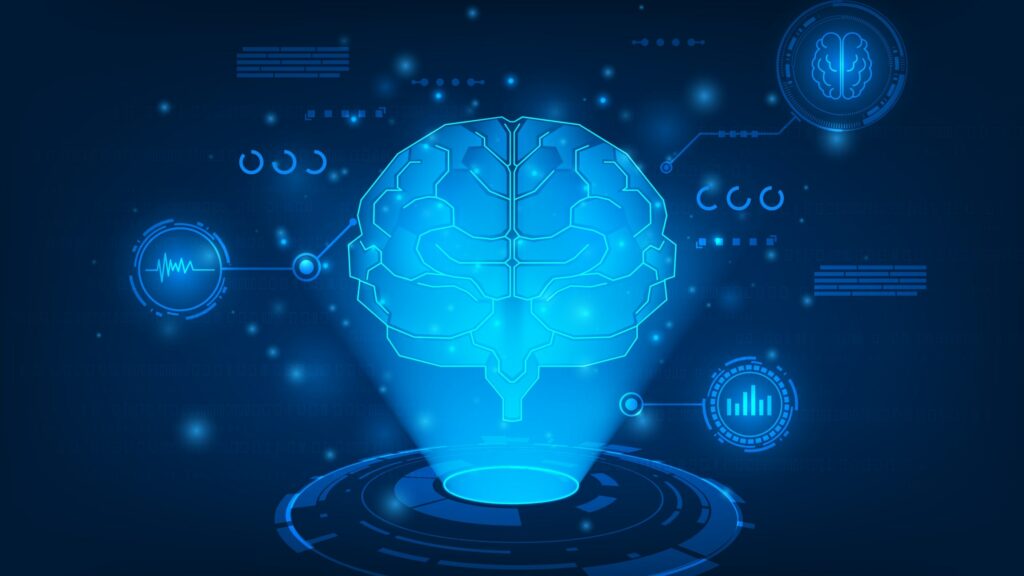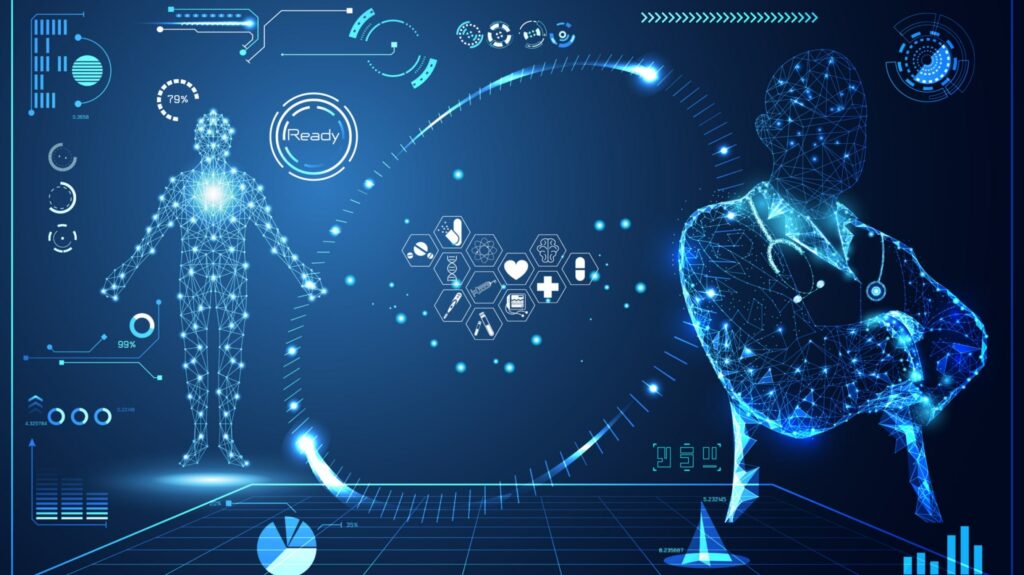As we navigate the complexities of the 2024 economic landscape, the healthcare ecosystem stands at a crossroads, facing a series of crises from labor shortages and staff burnout – to decreased profitability and worsening health outcomes.
The industry has made attempts to incrementally solve these issues, but our progress toward equitable, quality healthcare delivery remains elusive. Is generative AI, with its potential to transform these challenges into opportunities, our beacon of hope?
Today, consumers are already using Generative AI for healthcare needs, and healthcare leaders have already expressed activity, investment, and plans to implement it across their workflows:
- 75% of leading healthcare companies are already experimenting with generative AI or attempting to scale across the enterprise
- 82% currently have or plan to implement governance and oversight structure for generative AI
- 92% of leaders overwhelmingly see promise for generative AI to improve efficiencies
- 65% of leaders see promises to enable quicker decision-making
This article will explore how generative AI may be used to disrupt today’s care models and create new ways to deliver medicine.
An Introduction to Generative AI in Healthcare
Generative AI is already making waves in various industries, yet its potential to revolutionize healthcare is just starting to emerge.
The Fundamentals of Generative AI
Generative AI fundamentally relies on training an algorithm with a carefully selected dataset to generate completely new data. This procedure frequently involves sophisticated methods such as neural networks or dynamic systems composed of interconnected nodes designed to process and analyze complex datasets.

The basic workflow of generative AI has three main steps:
- Training: The generative model goes through thorough training with the given dataset. Gradually, its settings are fine-tuned to reduce the gap between the generated and training data.
- Generation: After training, the model becomes a source of creativity, producing fresh data points by drawing from the learned hidden space or other acquired forms.
- Assessment: The produced data is then evaluated, either using measurements or human assessment, to confirm consistency with the training data.
Key Differences Between Generative AI and Traditional AI
- Traditional AI, commonly known as Narrow or Weak AI, concentrates on executing a specific task based on logic. It relates to systems crafted to react to a defined group of inputs, gather insights from data, and formulate decisions or forecasts accordingly.
- Generative AI, meanwhile, involves a group of AI systems that can autonomously create entirely new data. By grasping the patterns and frameworks of human language, code, visuals, videos, and music, generative AI, powered by large language models (LLMs), can comprehend concepts contextually. This process enables computers to generate novel outputs that are similar to human-generated ones.
Overall, the primary distinction between traditional AI and generative AI lies in their functionalities and utilization. Traditional AI systems are predominantly used for data analysis and predictive tasks, whereas generative AI generates completely new outputs resembling its training dataset.
Applications of Generative AI in Healthcare
1. Facilitate Medical Imaging
Generative AI models can produce artificial images that closely resemble real images. They are trained using extensive healthcare data sets containing various disease categories, enabling them to generate models for any of these conditions. DALL-E 2, GLIDE, and ChatGPT are among the notable generative AI models utilized for imaging purposes.
2. Reduce Administrative Burnout
Generative AI is making big changes in healthcare by tackling the overwhelming paperwork and data entry tasks that often wear down doctors and nurses. By automatically filling out forms and managing patient records, this technology helps healthcare workers spend less time on administrative duties and more time caring for patients. This smoother process not only reduces stress for medical staff but also makes patient care more efficient and focused.
3. Interpret Unstructured Data
Medication records, EHRs, or medical visuals like MRIs, X-rays, and PET scans are some common types of unorganized data. These unstructured types of data may lead to discrepancies in analysis. Therefore, they need to be converted into a more structured format so that the healthcare information system can handle them. Generative artificial intelligence (AI) can detect unstructured data and convert it accordingly, based on its algorithm to evaluate various sources of information.
4. Facilitate Medical Diagnosis
AI-driven healthcare solutions can analyze patient information, including their health history, genes, and lifestyle, to create treatment plans just for them. This helps make treatments more accurate and effective.

AI can also potentially improve how well medical imaging technologies like X-rays, MRIs, and CT scans work. Analyzing the larger data set to help doctors find health problems more clearly.
5. Accelerate Drug Discovery
Generative AI is powerful because it can quickly scan through many chemical combinations to find promising drugs. This lets scientists move through the complex process of developing new medicines more smoothly, helping them make breakthroughs in treating hard-to-cure diseases.
Moreover, generative AI helps speed up drug discovery and increases the chances of finding effective ones. By examining a wide range of possibilities, researchers can discover new compounds that might be used to treat various health conditions.
6. Create Personalized Treatment Plans
Generative AI models can analyze information like a patient’s genes, medical history, and current medications to create tailored treatment plans. They may also give healthcare professionals up-to-date, data-backed advice on different treatment options based on a patient’s specific health needs, helping them choose the right treatments for each condition.
7. Support Clinical Decision-Making
Generative AI, combined with predictive analytics, has the potential to access extensive datasets and can respond to input data by extracting that information – to guide doctors in making important clinical decisions. Due to the potentially extreme impact of AI hallucinations on patient outcomes, further research is required to fully explore this generative AI application in the healthcare industry before we expect widespread use in clinical settings.
Special note: Decisions on how and where to integrate generative AI into operations should be strategically aligned with a clear understanding of the potential risks. In selecting a use case to deploy, leaders must evaluate each idea on its merits across six key areas: impact, function, measurability, permission space, time to market, and extensibility.
A Step-by-step Guide to Develop a High-Performing Generative AI Solution
Let’s now explore the practical elements of a generative AI. Use these steps to start your venture in developing an inventive and self-sufficient generative AI solution in healthcare.

- Evaluate the landscape and set goals
- Collect data
- Choose the right platforms and experts
- Identify and solve bias challenges
- Conduct regular improvement checks
1. Evaluate the Landscape and Set Goals
To effectively deploy a generative AI solution in the healthcare sector, it’s vital to first define the specific tasks it will perform.
- Prioritize functions that are highly complex or resource-intensive. The AI should be trained on historical data for accuracy and relevance in each chosen task.
- Analyze implications and organizational hurdles. Dive deep into the implications of generative AI on business operations, pinpointing both potential hurdles and lucrative opportunities.
- Evaluate your existing data infrastructure’s capability to support AI objectives, such as data engineering, machine learning operations, data quality, data privacy, data integrations, governance, and scalability. Based on the assessment, make necessary investments to upgrade and optimize the infrastructure
2. Collect Data
To start creating a generative AI solution, relevant data is needed to power the algorithm. The effectiveness of these AI models relies on the data quality they’re trained on. High-quality data, free of errors and inconsistencies, is crucial for accurate and reliable AI-driven decisions. Meanwhile, errors or biases in the data can lead to unreliable results and potential treatment errors, especially in healthcare.
Healthcare institutions now use synthetic data for electronic health records to comply with data privacy laws, ensuring patient confidentiality. Strict data storage and adherence to regulations like HIPAA and GDPR are vital to protect sensitive health information and maintain trust in healthcare AI applications.
3. Choose The Right Platforms and Experts
Not all Gen AI platforms are equal. Some excel in natural language processing for chatbots, while others shine in data analysis for clinical decision-making. Carefully selecting AI tools is therefore crucial for organizational goals.
In addition, a successful generative AI healthcare project requires the right team. Construct a multidisciplinary team that comprises AI specialists, data scientists, data analysts, and engineers, as well as business strategists and other stakeholders. This team will likely be crucial to drive AI projects and ensure they align with business objectives.
Consider engaging with system integrators and technology partners who can provide additional expertise, resources, and insights.
4. Identify and Solve Bias Challenges
AI model bias presents a notable challenge that can result in inaccurate results. For instance, if an AI system utilized in a healthcare setting is predominantly trained on medical data from male patients, it may exhibit shortcomings in diagnosing illnesses in female patients. And, although men and women do not possess entirely distinct physiological characteristics, elderly women are more prone to fractures than men due to osteoporosis.
Addressing AI model bias involves several key steps:
- Ensuring that the training data is inclusive and reflective of the demographic the model aims to support.
- Incorporating ethical considerations and fairness metrics into the AI development process.
- Periodically evaluating AI models for bias by scrutinizing the model’s outcomes across different demographic segments.
Developing an AI algorithm should prioritize transparency and interpretability. Gaining insights into the rationale behind a model’s decisions is critical for the identification and mitigation of biases.
5. Conduct Regular Improvement Checks
Bias correction is an ongoing process rather than a one-time endeavor. With the frequent emergence of new advancements, continuous monitoring and updating of AI models therefore are imperative.

Conduct risk assessments for all AI models within your solutions to evaluate each model’s innate risk for bias, operational mishaps, hallucinations, confidentiality, and ethics.
To effectively conduct assessments on your model:
- Oversee your AI system’s performance regularly, evaluating its precision, efficiency, and alignment with user requirements.
- Periodically retrain your models using updated data to sustain their precision and pertinence regarding that AI models may become obsolete due to the availability of new data or shifts in user demands.
- Gather and evaluate feedback from users of your AI system, such as healthcare professionals and patients, as valuable insights for developing an efficient AI algorithm.
Special note: Organizations have various entry points to kickstart a generative AI activation strategy. The key is to rethink how to frame the business problem and desired outcome, taking a problem-first, technology-second approach, rather than a technology-first, problem-second approach.
The Promising Future of Generative AI in Healthcare
Although generative AI has just entered the market, many startups and well-established firms are competing to emerge as the frontrunners in generative AI healthcare technology.

- Microsoft revealed its intention to incorporate generative AI into clinical software from Epic, the largest U.S. hospital EHR provider. They collaborated on initial implementations of GPT in EHR processes for responding to patient messages automatically. Additionally, they are introducing generative AI to Epic’s hospital database, enabling non-experts to ask AI general queries without the need for a data expert to access specific data.
- Google is entering the competition with its new large language model, Med-PaLM 2, offered to select users for trial purposes. Unlike typical AI algorithms, Med-PaLM is trained on medical data to analyze vast healthcare information efficiently.
- Generative AI also shows promise in simplifying medical note-taking. Physicians spend around six hours daily documenting notes in their EHR. Nuance, a documentation company of Microsoft, has recently launched generative AI into its clinical note-taking software, DAX Express. This product is claimed to be a fully automated clinical documentation tool that is the first to merge proven conversational and ambient AI with GPT-4.
Excitement abounds regarding potential future applications of generative AI. But while this technology offers vast possibilities in healthcare and beyond, it also presents ethical and regulatory considerations like safeguarding patient privacy and security, establishing standards, and ensuring unbiased AI-generated results. Addressing these concerns will lead to a new chapter of using generative AI to revolutionize the healthcare industry to be more patient-centric, streamlined, and data-driven.
FAQs
What are the ethical concerns surrounding the use of generative AI in healthcare?
Generative AI in healthcare raises several ethical concerns that need to be carefully addressed. One major issue is the potential for bias in the data used to train these AI models, which can lead to inaccurate or unfair outcomes for certain groups of patients. Additionally, there are concerns about privacy and security when it comes to the sensitive medical information that these AI systems handle. Ensuring transparency in how generative AI is used in healthcare, as well as taking steps to mitigate bias and protect patient data, are crucial in navigating the ethical considerations associated with this technology.
How is generative AI regulated within the healthcare sector to ensure patient safety?
Generative AI in the healthcare sector is regulated through a combination of guidelines, policies, and oversight mechanisms to uphold patient safety, data privacy, security, transparency, and accountability. In particular, regulatory bodies such as the FDA and similar organizations worldwide play a crucial role in establishing frameworks for the development and deployment of AI technologies in healthcare.
Are there any successful real-world examples of generative AI applications in healthcare?
Yes, one of the most successful cases is with Mass General Brigham, the parent organization of Brigham and Women’s Hospital and Massachusetts General Hospital. The organization has swiftly implemented generative AI in response to the COVID-19 surge. A chatbot, inspired by the Providence health system’s success, fielded over 40,000 patient inquiries in its debut week. By adapting CDC screening questions, Mass General Brigham’s AI voice system efficiently addressed callers’ concerns, offering referrals as needed.
Take Strategic Steps Into the HealthTech Future With KMS Healthcare
With all of the continuous advancements, generative AI can either build or erode trust in healthcare. Navigating these changes can be challenging, but partnering with a technology provider like KMS Healthcare eases the burden. KMS offers expertise in integrating and enhancing a range of AI technologies for your healthcare organizations, including process automation, actionable analytics, and query chatbots, to enhance healthcare organizations’ effectiveness and efficiency.
Book a consultation with us and start your journey with generative AI now!

Reference
World Economic Forum. Patient-First Health with generative AI: Reshaping the Care Experience [Whitepaper].
(n.d.). Tackling healthcare’s biggest burdens with generative AI. McKinsey. https://www.mckinsey.com/industries/healthcare/our-insights/tackling-healthcares-biggest-burdens-with-generative-ai
(n.d.). How generative AI – A Technology Catalyst – Is Revolutionizing Healthcare. Forbes. https://www.forbes.com/sites/billfrist/2023/08/01/how-generative-ai–a-technology-catalyst–is-revolutionizing-healthcare/?sh=4299e9045013

